After spending 3days and 2 nights in the city of Udaipur, we four friends started exploring the surrounding of Udaipur. The famous Haldhi Ghati, Kumbhal Garh Fort-The Great wall of India, Ranakpur,( the architechture and sculpture wonder) to Mount Abu.

Badshahi Bagh: Two kilometers before the pass is the site of Badshahi Bagh, where Mughal Army set up their tents, when they realized that it would be very difficult to face Pratap’s gurrilla army in the fierce battle. Badshahi Bagh is now an ASI protected area having a large platform made of stones and surrounded by beautiful flowers all around.
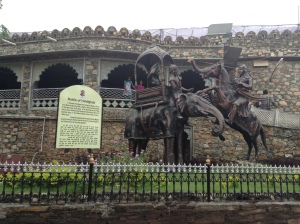
From this place after traveling one hours, we r
2. Nearby Temples that include Ganesh Temple, Swami Narayan Temple, Neelkanth Mahadeva Temple, Vedi Complex etc: After entering through the main entrance, you come across the group of temples at both sides of the main entrance. At the left hand side there is a Ganesha Temple and a Swami Narayan Temple. At the right hand side, there is a Vedi Complex, Neelkanth Mahadeva Temple, Parsvanath Temple etc. Many of these temples were built during the reign of Rana Kumbha.

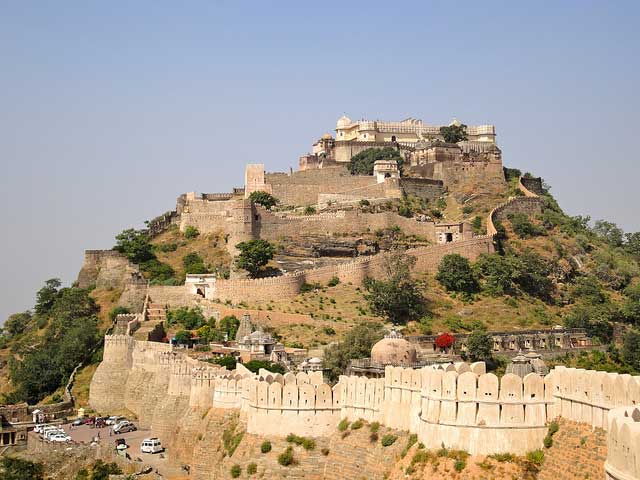

best time to visit is late afternoon as it is less crowded
luggage room at Ranakpur is availble you can keep your bags at luggage room AFTER paying a storage fee .
you can also take bus from jodhopur 163 km drive and take 5 hours .
by train – nearest railway station is falna . you can take a bus from falna to Ranakpur it take 45 minutes express bus. taxi are easily availble at Falna station or you can pre book the transfer
Cost of car :
Ranakpur same day tour from udaipur AC Mid size car 2200 Rupees Including toll tax and Parkings
Ranakpur same day tour from udaipur AC Toyota Innova 3200 Rupees including toll tax and parking
You can add Kumbhalgarh tour with your Ranakpur same day tour @ 500/- rupees top up price
Youcan add Jodhpur drop with this tour @ 2900 rupees add on Ranakpur same day tour
Jain food in side the temple complex :
Food availble between 12:!5 PM to 1:15 Pm @ 50 Rupees per person. it is veg food and served in a hall by the workers. it is good food as well
Hotel and restaurant in Ranakpur :
Kings abode –
Maharani Bagh
Fateh Bagh
Mana Hotels
Ranakpur Hill Resort
Rupam Hotel
Arnyawas
Temple trust started charging entry fee to every international visitor . Every visitor has to pay Rs 200 to enter in temple.Thus , after enjoying tea and snaks at hotel Maharani Bagh, in the evening we started our journey to next Destination and only Hill station of rajasthan Mount Abu.In the next post the details regarding mount abu and other important monuments like Delwara Jain temple etc will be there. Though the day was hectic , but the architecture and the history and zeal to see the new places did not affect Us physically.
After experiancing this , I recommend the the future travellers to keep one day for haldighati and Kumbhalgarh. Stay at Kumbhalgarh and next morning after breakfast start journey to Ranakpur and u will easily finish ur tour by evening. and after that you can plan your journey accordingly.

Photo: Kumbhal Garh Fort
How to Reach Haldighati? Haldighati is a remote village, off the main highway in Rajsamand district of Rajasthan. It is about 40 kms from Udaipur. Udaipur is a major city connected to the many parts of India by Rail and Air. After reaching Udaipur, Haldighati can be easily reached by the public buses or hired vehicle. Haldighati lies on the route between Udaipur-Eklingji-Haldighati-Kumbhalgarh-Ranakpur, all are famous tourist hotspots in the region. Therefore by using a hired vehicle or own vehicle, all these places can be covered in a single day.
The Battle of Haldighati:
The battle of Haldighati is one of the most important chapter of the
Indian History. In that battle of 1576 A.D., 1200 gurilla soldiers led
by Mewar pride Maharana Pratap fought fiercely with the strong Mughal
Army of 40000 soldiers led by Raja Man Singh.
Maharana Pratap was the ruler of Mewar,
who never accepted the slavery of The Mughal Emperor Akbar and always
considered him as an invader. In 1576, a strong Mughal Army led by Man
Singh marched towards Haldighati Pass, a narrow pass in the Aravali
Hills surrounded by thick forest and thorny bushes. The relatively
lesser members of Pratap’s Army decided to fight a Gurilla war and
forced Mughal Army to move towards an open battleground. A fierce battle
was fought in a open battleground and lot of blood were poured turning
the battlefield in a pool of blood, that is now known as Rakt Talai.
During that war, Pratap was injured
severely. To save his precious life, Mana Jhala put the royal envisage
on his head and allow Pratap to flew from the battleground. Mughal army
attacked on Mana Jhala mistaking him as Pratap. Mana Jhala sacrificed
his life in the battlefield. On the other hand, the loyal horse of
Pratap, Chetak, also got severe injuries, while moving away from the
battlefield. Despite of all its injuries, Chetak carried his master
away from the battlefield safely and finally felt down on the ground
while jumping over a stream and died in the lap of Pratap. That very
spot has a samadhi (tomb) of Chetak now. It is a great tribute to the
horse who served his master till the last breath.
Nobody was the clear winner in the
battle of Haldighati. Thereafter, Mahatma Pratap lived larger part of
his life in the forest, where, sometimes, his children were forced to
eat the chapatis (bread) made of grass. He never accepted the monarchy
of Akbar and fought in his entire life using gurrilla war techniques.
Present Day Haldighati: In the course of time, all the
blood has been washed away and the great battle became a part of the
history. Haldighati pass is still a narrow pass, but a well paved road,
in the Aravali hills surrounded by the forest of thorny bushes. The soil
of Haldighati is in turmeric yellow color, the reason behind its name
Haldighati (Haldi:Turmeric).
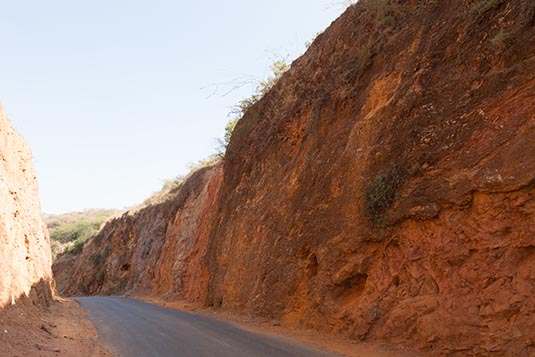

Photo: Haldighati
Badshahi Bagh: Two kilometers before the pass is the site of Badshahi Bagh, where Mughal Army set up their tents, when they realized that it would be very difficult to face Pratap’s gurrilla army in the fierce battle. Badshahi Bagh is now an ASI protected area having a large platform made of stones and surrounded by beautiful flowers all around.
Cultivation of Chaitri Roses: The area around Badshahi
Bagh is now famous for the cultivation of roses, specially “Chaitri
Roses”. These roses are a breed of pink rose, which only bloom in the
month of March-April, the Hindu month Chaitra, hence the name. The
farming of these roses are at very large scale in Haldighati. These
roses are basically used in the production of scent, sharbat, rose
juice, gulkand and rose water.
There are lot of shops along the road near Badshahi Bath, selling the
products made of Chaitri Roses.They are really genuine product at
reasonable prices and definitely worth buying. A shopkeeper took me to
his farm of the roses to show me the flower an its plantation. They even
arrange home delivery of these products on the request.
Chetak Samadhi: Approximately one km from the
Haldighati Pass, there is a samadhi (tomb) of Chetak, along the main
road. This memorial was built in the memory of the supreme sacrifice
that loyal horse made while saving the life of his master. The samadhi
complex has Chetak’s grave surrounded by the floral garden, which is
nicely maintained.
Maharana Pratap Haldighati Museum: Moving 2 kms ahead
of Chetak Samadhi, there is a fort like structure on the left side of
the road. This is not a fort, but a museum actually. Maintained by Shri
Mohan Lal Shrimali as a private museum, it showcased the entire battle
of Haldighati and life of Pratap through the paintings and pictures. The
entry fee to the museum is INR 20.

Photo: Haldighati Museum
After visiting the museum of Maharana Pratap, I continued on the same road leading to the mighty fort of Kumbhalgarh and further to the famous Jain Temples of Ranakpur.The Great Wall of India at Kumbhalgarh Fort
Kumbhalgarh is a
gorgeous, massive and almost invincible fortress situated on the top of
the Aravali Hills in the middle of a forest turned into a wildlife
sanctuary. Built by Rana Kumbha in 15th century, its unique location and
its grandeur makes it a must visit place in that part of Rajasthan. It
is believed that Rana Kumbha built about 32 forts during his reign, of
which Kumbhalgarh is the largest and most elaborate. This fort is
inducted in the list of UNESCO World Heritage Sites in the month of
June, 2013 along-with five other hill forts of Rajasthan.
Location: This fort is
situated about 82 kms northwest of Udaipur city in the district of
Rajsamand, Rajasthan. The famous Jain Temple of Ranakpur is about 45 kms
away from this fort by road.
How to Reach? The best
way to visit this fort is by taking a single day tour from Udaipur
along-with Ranakpur Jain Temple. There are many tour operators in
Udaipur offering this single day tour service.
Udaipur is major city in the Southern
Part of Rajasthan and a very popular tourist destination in the
worldwide tourism circuit. Udaipur is well connected to the major cities
of India by Road, Rail and Air Transport. Two National Highways NH-8
and NH-76 pass through the city. Regular AC Sleeper as well general
buses connect Udaipur to Major cities like Ahmedabad, Jaipur, Jodhour,
Indore and Delhi. It is also a major Railway Junction with a good
connectivity to Delhi, Mumbai, Ahmedabad and other major cities of
India. Udaipur Airport is connected to many cities in India by scheduled
domestic flights operated by major carriers. Delhi as well as Mumbai is
connected to Udaipur on Air India and Jet Airways Network with daily
scheduled flights.
After reaching Udaipur, The road
transport is the only option to travel to the Kumbhalgarh Fort. There is
no rail as well as flight connectivity to Kumbhalgarh. There is no
regular public buses plying on this route. Either book a private cab
from Udaipur or join any of the single-day private tour offered by
numerous tour operators in Udaipur.
Some sources also suggest to catch a
train to Phalna Junction, which is connected to Mumbai, Udaipur,
Jodhpur, Ahmedabad,Jaipur and Delhi by express trains and about 95 kms
away from Kumbhalgarh. From there, again you have to arrange a private
taxi to Kumbhalgarh Fort. I highly recommend you to plan your journey
from Udaipur instead of Phalna. It will be more convenient, more
comfortable and more economical compared to a transport arrangement from
Phalna. Better to get a whole day package from Udaipur to include all
nearby places like Eklingji Temple, Battlefield of Haldighati,
Kumbhalgarh Fort, Ranakpur Jain Temple and Nathdwara.
Our Trip to Kumbhalgarh
After visiting Haldighati, the famous battle field, our next target was Kumbhalgarh Fort " The Great Wall of India". After passing the lush green fields of Roses , our taxi reaches to different kind of landscape. We stopped at one place called KATAR river. On the Katar River there is Bund and one Banyan Tree . On this Banyan tree one Hindi movie Dhamal `s shooting was done.
From this place after traveling one hours, we r
Entry Ticket and Timings:
The entry ticket of Kumbhalgarh Fort for an Indian national is INR 10
only and for Foreign Nationals it is INR 100 only. Digital Cameras are
allowed inside the fort without any cost. Fort remains open from 8.00
AM to 6.00 PM daily throughout the year.
Like Chittorgarh Fort, private vehicles
are not allowed on the road inside this fort, so you have to walk a lot
to visit the attractions inside the fort area. There are some main
attractions like palaces and temples located closed to the main entrance
and those can be visited in 2-3 hours, but if you want to see the other
temples and attractions like Gole Rao Group of Temples, some Jain
Temples, Prithviraj ki Chhatri etc, then it will take about 4-5 hours to
explore the entire complex.
Best Way to Visit Kumbhalgarh Fort:
Kumbhalgarh Fort is a part of Kumbhalgarh Wildlife Sanctuary that
spread in the area of 578 sq.kms. around Kumbhalgarh and Ranakpur. Youth
Hostels Association of India offers a regular trekking expedition once
in a year in the month of November from Ranakpur to Kumbhalgarh and then
to Muchalla Mahavir Temple. This 5 Days/4 Nights trekking expedition
covers the total of 40.5 kms trekking in Kumbhalgarh Wildlife Sanctuary
including the Kumbhalgarh Fort. Return journey of 25 kms from Muchalla
Mahavir Temple to Ranakpur is covered by bus. This expedition fee is INR
3010 inclusive of Stay, simple nutritious Vegetarian Food,
Transportation, Guidance, Equipment and Insurance for Youth Hotsel
Members and do not include to and fro journey from the hometown to the
base camp in Ranakpur. In my opinion, this is the best option to explore
the fort area , wildlife sanctuary as well as the Jain temple of
Ranakpur, if you have 5-days time to spend in that area.
Attractions at Kumbhalgarh Fort:
1. Massive Entrance, Ram Pol: The massive entrance gate of the fort is known as Ram Pol. This gate itself is a symbol of the sheer grandness of this fort.
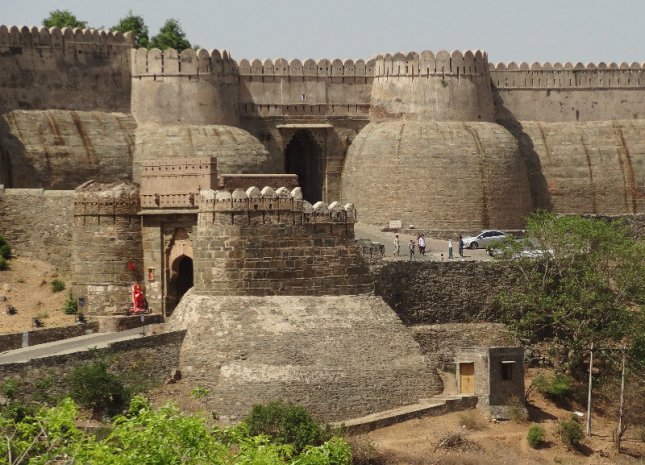

Photo : Entry To Fort
2. Nearby Temples that include Ganesh Temple, Swami Narayan Temple, Neelkanth Mahadeva Temple, Vedi Complex etc: After entering through the main entrance, you come across the group of temples at both sides of the main entrance. At the left hand side there is a Ganesha Temple and a Swami Narayan Temple. At the right hand side, there is a Vedi Complex, Neelkanth Mahadeva Temple, Parsvanath Temple etc. Many of these temples were built during the reign of Rana Kumbha.

Photo: Vedi Temple (Kumbhalgarh Fort)
3. Palaces that include Kumbha Palace, Badal Mahal and the Birthplace of Maharana Pratap: There are mainly three palaces inside the fort at different heights. A road from the main entrance leads towards the palaces along the Ganesha Temple and Swami Narayan Temple. After passing through a gate known as Pagda Pole, you come across the first palace, Kumbha Palace. This palace, a two storeyed edifices, consisting of two rooms, a corridor and some open spaces, are now in a highly ruined state.
Photo: Different Palaces inside Fort
Near Pagda Pol, along the Kumbha Palace,
there is another mansion known as Jhalia ka Malia or the Palace of The
Queen Jhalia. This is the place where Maharana Pratap was believed to be
born. The traces of old painting can still be seen on the wall.
Badal Mahal or The Palace of Clouds was
built by Rana Fateh Singh and named so because of its situation at the
highest point of the fort. The palace had a separate section for males
and females. In the female section, there were stone windows with jalis,
so that the queens and other ladies could see the court proceedings and
other events in privacy.
4. Temples beyond the entrance gate that include Gole Rao Group of Temples , Jain Temples etc:
Beyond the entrance gate, about 2 kms away, there are many temples
scattered in the fort area. If you are lacking of time, then better to
click them from the top of the Badal Palace. If you have time, you can
walk on a paved road going along the Vedi Complex and Neelkanth Mahadeva
Temple. Located in the middle of hilly terrains and surrounded by
thorny bushes, these temples are a perfect place to spend some moments.
There are about 360 small and big
temples scattered inside the Kumbhalgarh Fort. Of these 360 temples,
about 300 temples belong to Jain Deities and about 60 temples belong to
Hindu Gods and Goddesses.
Things to do:
1. Sit on the top of Badal Palace and see the expansion of wildlife sanctuary and the fort area:
Badal Palace is situated on the top of the Kumbhalgarh Fort. Roof of
this palace offer an excellent view of Kumbhalgarh Wildlife Sanctuary
spreading over the Aravali Hills.
2. Meet a local living inside the fort and listen the story of the construction of this fort: According
to the legend, when Rana Kumbha started construction of this fort, he
faced many difficulties and at a point of time, he thought to abandon
this construction. Then one day Rana Kumbha met a holy man, who
suggested that those difficulties would be end, if somebody would
sacrifice his life voluntarily. But that man should be a pure hearted
person. Nobody was like that. The King was very disappointed. Then, that
holy man offered his own sacrifice and advised the king to built the
main entrance where his beheaded head would fall and the palaces where
his body would fall. Rana Kumbha went ahead as per his advise after the
sacrifice and then this grand and majestic fort was constructed. You can
talk to any local people there, who will be happy to tell you this
story without any charge.
3. Click the pictures of The Great Wall of India: The
outer wall of this fort is believed to be the second longest wall after
the Great Wall of China. They are about 36 kms long and about fifteen
feet thick. ( however some sources say it is only 15 kms long now). From
the top of the Badal Palace, you can click many good pictures of this
Great Wall of India.
4.Locate numerous temples from a higher point:
At the top of the Badal Palace or any other higher point, you can check
your knowledge about the temples and other monuments inside the fort,
by simply locating them in that wilderness.
5. Walk on the massive wide walls of the fort:
Not all forts in India are so grand as Kumbhalgarh Fort and only few of
them provide an opportunity to walk on the outer walls. Kumbhalgarh
Fort is mightiest and grandest and you can also walk on its 15 feets
thick outer walls near the main entrance beyond the Vedi Complex.
6. Eat at a Restaurant closed to the entrance:
This fort is situated in the middle of nowhere, on the hills,
surrounded by a wildlife sanctuary. You will not find any good place in
nearby area to eat. So, better to eat at a decent restaurant inside the
fort near to the main entrance. The prices are of course inflated but
still affordable in the middle of nowhere.
7. Admire this fort from the view point:
About one km before to the main entrance of the Kumbhalgarh Fort, you
will find a notice board pointing towards the Kumbhalgarh Fort View
Point. That point provides an excellent outer view of this grand fort
and its mighty walls.
8. Enjoy Sound and Light Show:
Every evening the Kumbhalgarh Fort is illuminated with flood lights and
a special Sound and Light show starts at 6.45 PM on the story of Rajput
Royals.The show is only in Hindi language and organised by The
Rajasthan Tourism Development Corp. The ticket cost is INR 100 per
person for the Indian Nationals (Perhaps INR 250 for the foreigners).
This 45 minutes show is highly recommended , provided that you are
planing to stay there in the night.
9. Trek to Ranakpur Jain Temples:
The best way to explore the wildlife sanctuary, Kumbhalgarh Fort and
Ranakpur Jain Temples. If you have time, please try this trek once, and
to experience the best try it with Youth Hostels.
Where to Stay?
There are very few hotels (about 8-9) in Kumbhalgarh area and they are basically high-end heritage hotels or resorts. So from a backpacker’s point of view, those hotels are very expensive. It is better to stay in Udaipur and have a one day trip to Kumbhalgarh to return back by evening.
After finishing the Kumbhalgarh fort , our next halt was Ranakpur Jain Temple (45Km). The distance from Kumbhalgarh to Ranakpur is in good condition. Roadside the crops were good that includes sugercane, wheat and vegitables.
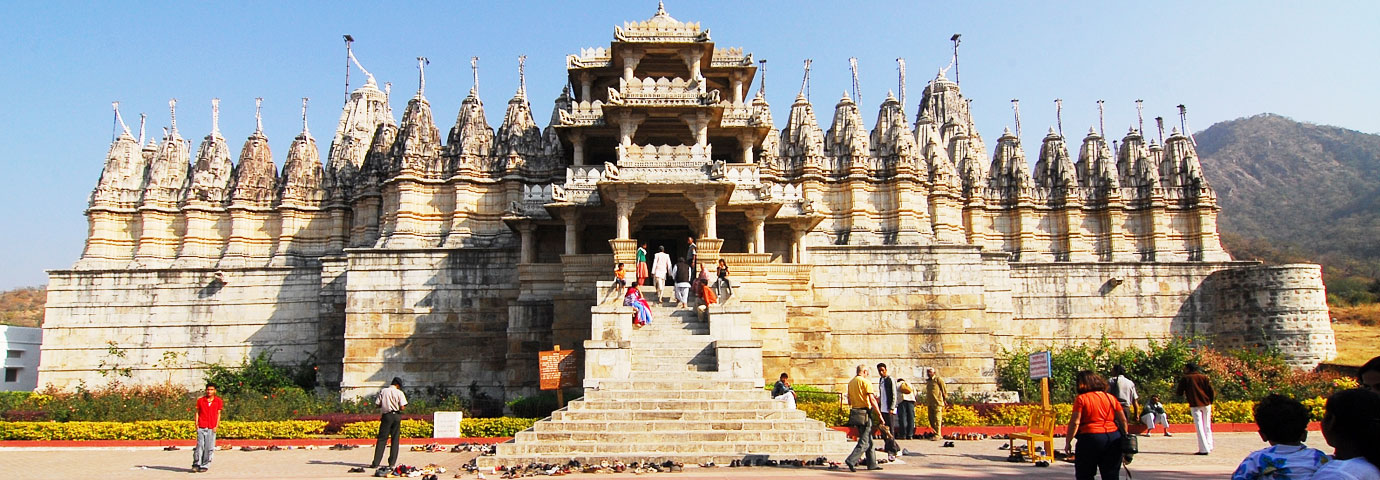
The Ranakpur Jain Temple was built by a wealthy Jain businessman named Dharma Shah under the patronage of the liberal and gifted Rajput monarch Rana Kumbha in the 15th century. According to local legend Dharma Shah had a celestial vision that left in his heart a burning determination to build a temple in honor of Adinath, the founder of the Jain religion. When Dharma Shah approached Rana Kumbha with his plan, the king not only gave him a plot of land to build the temple but also advised him to build a township near the site. The construction of the temple and the township began simultaneously. The town was named Ranakpur after the King Rana Kumbha.


There are very few hotels (about 8-9) in Kumbhalgarh area and they are basically high-end heritage hotels or resorts. So from a backpacker’s point of view, those hotels are very expensive. It is better to stay in Udaipur and have a one day trip to Kumbhalgarh to return back by evening.
After finishing the Kumbhalgarh fort , our next halt was Ranakpur Jain Temple (45Km). The distance from Kumbhalgarh to Ranakpur is in good condition. Roadside the crops were good that includes sugercane, wheat and vegitables.
The 1,444 Carved Pillars of Ranakpur Jain Temple No Two of Which Are Alike

Photo: Ranakpur jain temple
Ranakpur is a village located in the lush green valley of Aravalli mountain ranges in Pali district of Rajasthan, in western India. It is home to one of the biggest and most important Jain temple complexes of India, covering an area of nearly 48,000 square feet area, and has 29 halls, 80 domes and supported by 1444 marble pillars, each of them intricately and artistically carved, yet no two of them are alike.The Ranakpur Jain Temple was built by a wealthy Jain businessman named Dharma Shah under the patronage of the liberal and gifted Rajput monarch Rana Kumbha in the 15th century. According to local legend Dharma Shah had a celestial vision that left in his heart a burning determination to build a temple in honor of Adinath, the founder of the Jain religion. When Dharma Shah approached Rana Kumbha with his plan, the king not only gave him a plot of land to build the temple but also advised him to build a township near the site. The construction of the temple and the township began simultaneously. The town was named Ranakpur after the King Rana Kumbha.

Photo: Exquisite marble roof that looks more like lace-work
The temple is said to have cost 10 million Rupees and took more than fifty years to build. The entire building is covered with delicate lace-like carvings and geometric patterns. The domes are carved in concentric bands and the brackets connecting the base of the dome with the top are covered with figures of deities.
Photo: The carving Inside temple and on the pillers
For two centuries, the temple was a beacon of devotion before it fell upon hard times. Around the 17th century, the entire region was ravaged by war. Fearing that the statues would be desecrated, the priests hid them in cellars under the temple and fled the area. The invading forces vandalized the temple and left, but the priests never returned. The temple fell into neglect and gradually the elements began to take over. At one point Ranakpur became a refuge for dacoits and no person dared to venture inside. It was only around the first quarter of the 20th century that people realized the immense crime they were committing by allowing this structure of beauty and devotion to rot away, and the temple was restored to its former glory.
Photo : Main Prayer Hall of the temple
“In spite of the complexity, the vast expanse and the loftiness of the temple, the architectural balance and symmetry are not the least affected,” reads a description of the temple at Ranakpurtemple.com
The artiste sculptures which lie scattered like precious jewels, the myriad ornate Toranas' or festoons with minute and delicate carvings, the innumerable elegant and lofty pillars and a large number of Shikharas, (spires) which make a unique pattern on the face of the sky-all these works of spiritual art, as one approaches them, become alive and make the beholder oblivious of all else but a feeling of ecstasy, as if touched by the sublimity of Divine Bliss.The most outstanding feature of this temple is its infinite number of pillars.
In whichever direction one might turn one's eyes meet pillars and pillars big, small, broad, narrow, ornate or plain. But the ingenious designer has arranged them in such a manner that none of them obstructs the view of the pilgrim wishing to have a Darshana' (glimpse) of God. From any corner of the temple one can easily view the Lord's image. These innumerable pillars have given rise to the popular belief that there are about 1444 pillars in the temple.Visit and timing of Ranakpur jain temple 12 noon to 5 pm Temple open for non jain for above time and it is open for jain communities whole day,.You can hire a udaipur guide to explain sarrounding of the the main temple. one can hire a car and guide from udaipur to do a day trip to ranakpur jain temple . there are entry fee for foriegner and camera fee for every visitor . temple donot allowed any leather articles, drinking water , food inside the temple. if you are carring a mobile phone with camera . you will be insist to buy camera tickets or deposit your camera with locaker nera tickets window.
best time to visit is late afternoon as it is less crowded
how to reach –
By Bus – there are bus from rajasthan roadways. and it take around 3 hours – 4hours early morning bus to ranakpur is 5;15 am next buses are 7 am and 8;30 am from udaipur to cover distance 100 km,luggage room at Ranakpur is availble you can keep your bags at luggage room AFTER paying a storage fee .
you can also take bus from jodhopur 163 km drive and take 5 hours .
by train – nearest railway station is falna . you can take a bus from falna to Ranakpur it take 45 minutes express bus. taxi are easily availble at Falna station or you can pre book the transfer
by car : you can hire a car from udaipur to reach ranakpur temple And back to udaipur or drive to Jodhopur .
by air ; nearest airport is udaipur airport and it take 2 hours to drive from airport to ranakpur jain temple cost of Car from udaipur airport to Ranakpur jain temple 2700 Rupees including visit of Ranakpur jain temple and drop to your hotel in RanakpurCost of car :
Ranakpur same day tour from udaipur AC Mid size car 2200 Rupees Including toll tax and Parkings
Ranakpur same day tour from udaipur AC Toyota Innova 3200 Rupees including toll tax and parking
You can add Kumbhalgarh tour with your Ranakpur same day tour @ 500/- rupees top up price
Youcan add Jodhpur drop with this tour @ 2900 rupees add on Ranakpur same day tour
Jain food in side the temple complex :
Food availble between 12:!5 PM to 1:15 Pm @ 50 Rupees per person. it is veg food and served in a hall by the workers. it is good food as well
Hotel and restaurant in Ranakpur :
Kings abode –
Maharani Bagh
Fateh Bagh
Mana Hotels
Ranakpur Hill Resort
Rupam Hotel
Arnyawas
Temple trust started charging entry fee to every international visitor . Every visitor has to pay Rs 200 to enter in temple.Thus , after enjoying tea and snaks at hotel Maharani Bagh, in the evening we started our journey to next Destination and only Hill station of rajasthan Mount Abu.In the next post the details regarding mount abu and other important monuments like Delwara Jain temple etc will be there. Though the day was hectic , but the architecture and the history and zeal to see the new places did not affect Us physically.
After experiancing this , I recommend the the future travellers to keep one day for haldighati and Kumbhalgarh. Stay at Kumbhalgarh and next morning after breakfast start journey to Ranakpur and u will easily finish ur tour by evening. and after that you can plan your journey accordingly.